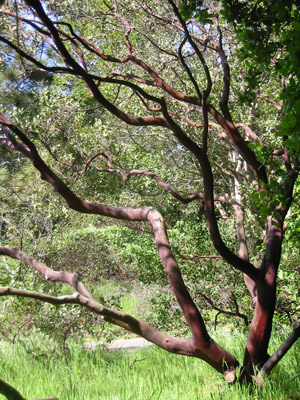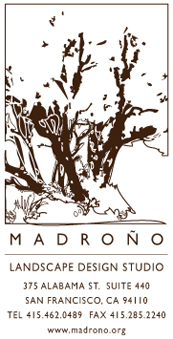 Standing solemnly in the middle of the hectic San Francisco peninsula, San Bruno Mountain nurses a pocket of pre-Colombian life largely unchanged by modern times, a rural island in an urban sea. Harvard biologist Edward O. Wilson ranks this site among the world's greatest "biodiversity hot spots" alongside Madagascar, Borneo, and the forests of Tanzania. These 3,000-plus acres of open space support more than 250 species of native plants, approximately 40 varieties of butterfly (including four rare and endangered species), and multiple robust interdependent communities of mammals, reptiles, amphibians, and birds. Such fertile associations give voice to an ancient and fundamental story, an epic neither silenced by the drone of traffic on nearby freeways 101 and 280 nor intimidated by the bustle of moat-like burgs Daly City, Colma, Brisbane, and South San Francisco "The Industrial City" self-proclaimed in large white letters on SBM's southern flank.
Standing solemnly in the middle of the hectic San Francisco peninsula, San Bruno Mountain nurses a pocket of pre-Colombian life largely unchanged by modern times, a rural island in an urban sea. Harvard biologist Edward O. Wilson ranks this site among the world's greatest "biodiversity hot spots" alongside Madagascar, Borneo, and the forests of Tanzania. These 3,000-plus acres of open space support more than 250 species of native plants, approximately 40 varieties of butterfly (including four rare and endangered species), and multiple robust interdependent communities of mammals, reptiles, amphibians, and birds. Such fertile associations give voice to an ancient and fundamental story, an epic neither silenced by the drone of traffic on nearby freeways 101 and 280 nor intimidated by the bustle of moat-like burgs Daly City, Colma, Brisbane, and South San Francisco "The Industrial City" self-proclaimed in large white letters on SBM's southern flank.
Much of the mountain is dry grassland, sun-scorched, appearing misleadingly drab to passing carloads of commuters. A closer exploration by foot reveals a hidden world of texture and color, subtleties and complexities. The onset of November rain awakens the landscape with a whisper of green, a slow murmur that builds through the winter to a lusty huzzah of early spring wildflowers. Enthusiasts hail SBM as the earliest bloomer in the Bay Area, and the most important native plant site in San Francisco. Even now, delicate fragrant blue-green shoots of California sagebrush (Artemisia californica) have appeared beneath the deadheads of last season, and plucky lizard tail (Eriophyllum staechadifolium) is resprouting everywhere.
But a wild west wind howls across these sandstone peaks, killing any plant that dares to grow too tall. This gives the evolutionary edge to those species best able to hunker down and hug the slope: many ordinarily-large shrubs grow flat like carpets, while oaks such as Quercus chrysolepis and Q. wislizenii -- which can reach 40-70 feet when growing inland -- go bonsai here at seven to eight feet.

